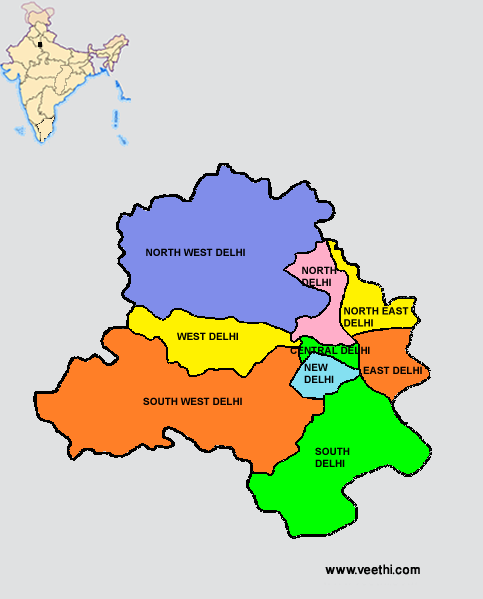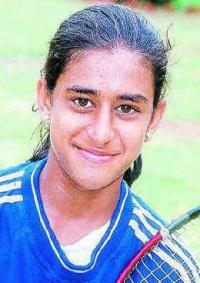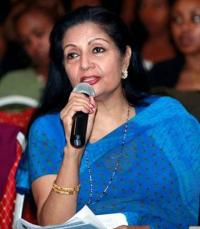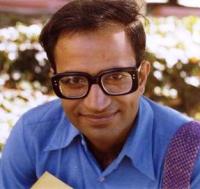Delhi is a Union Territory of India. It is the largest metropolitan city in India by area and second largest in India and eighth largest in the world by population. The capital of India, New Delhi lies within this metropolitan region. The name Delhi is derived from the word Dhillu or Dilu who was a king of Mauryan dynasty. It is also said the name originated from the name Dehleez which means gateway.
History of Delhi
The settlements in Delhi started from the time of Mauryan Empire in 300 B.C. The Delhi Sultanate was first established by Qutb Ud Din Aybak in 1206. Various dynasties namely Slave dynasty, Khilji dynasty, Tughluq dynasty, Sayyid dynasty and Lodhi dynasty held supremacy over Delhi at various periods of time. Mughal dynasty started to rule from Delhi in 1526. Mughal Empire became weak in 18th century and Marathas rose to power. However their rule was ended after the Second Anglo Maratha War in 1803.
After the First War of Indian Independence in 1857, Delhi was brought under the direct rule of the British crown. In 1911, the capital of British India was changed from Calcutta to Delhi. New Delhi, a newly designed political area became the capital of India after Indian independence. According to the Constitution Act 1991, the Union Territory of Delhi was changed into the National Capital Territory of Delhi.
Geography and Climate of Delhi
Delhi spreads over an area of 1484 square kilometers and among them 783 square kilometers is considered rural area and 700 kilometers as urban area. Delhi has Narela in the north, Ghitorni in the south, Seemapuri in the east and Najafgarh in the west. Delhi is one of the ten most polluted cities of the world and the 70% of the pollution is caused by the vehicles.

Delhi has a humid subtropical climate with long and hot summers and cold winters. The lowest temperature in Delhi in winter is -0.6 degree Celsius and the highest temperature in Delhi in summer is 46.7 degree Celsius. The annual mean temperature is 25 degree Celsius. The average annual rainfall in Delhi is 714 mm.
Divisions of Delhi
There are nine districts, 27 tehsils, 59 towns and 300 villages in Delhi as of June 2012. There are five local municipal corporations here such as North Delhi Municipal Corporation, South Delhi Municipal Corporation, East Delhi Municipal Corporation, New Delhi Municipal Council and Delhi Cantonment Board. There are 70 assembly constituencies and seven Lok Sabha constituencies in Delhi. The important government buildings, the Parliament of India, the Rashtrapathi Bhavan, Cabinet Secretariat and the Supreme Court of India are located in New Delhi.
Delhi State Map With Districts

List of Districts in Delhi
People and Culture of Delhi
According to the 2011 census, the population of Delhi is 16,753,235 and the density of population was 11297 people per square kilometers. The sex ratio of Delhi is 866 women per 1000 men. Hindi is the important language spoken by people of Delhi. Apart from this, Punjabi and Urdu are spoken commonly. However minority groups also speak Garhwali, Rajasthani, Bihari, Bengali, Sindhi, Tamil, Oriya, Telugu, Kannada and Malayalam.
The culture of Delhi is cosmopolitan in nature due to the high diversity of people living here. There are three world heritage sites here, Red Fort, Qutab Minar and Humayun’s Tomb. The monuments and edifices, the festivals like Diwali, Eid, Muharram, Buddha Jayanti, Lohri, Durga Puja, Chhath, Krisha Janmastami, the fairs and expos reveal the culture of Delhi. The largest Auto Expo in Asia is conducted here once in every two years.
Delhi cuisine is spicy with Punjabi and Mughlai delicacies. Kebabs, biryanis, tikki, golgappe, chaat, dahi papri are some of the common dishes here. The Indian handicrafts and handlooms are seen in Dilli Haat, Hauz Khas and Pragati Maidan.
Education and Sports of Delhi
The literacy rate of Delhi is 86.34%. As of 2004-05 there were 2515 primary schools, 635 middle schools, 504 secondary schools and 1208 senior secondary schools in Delhi. There were also 165 colleges among which 8 are engineering colleges and 5 are medical colleges. There are seven major universities here namely Delhi University, Jawaharlal Nehru University, Jamia Millia Islamia, Guru Gobind Singh Indraprastha University, National Law University, Indira Gandhi Open University and Jamia Hamdard University.
Some of the institutions of higher education are Indian Law Institute, Delhi School of Economics, Jamia Millia Islamia, Netaji Subhas Institute of Technology, National Law University, Delhi Technological University, Indian Institute of Foreign Trade, Jawaharlal Nehru University, School of Planning and Architecture and Dr. Ram Manohar Lohia Hospital.
The Jawaharlal Nehru Stadium in Delhi is the third largest of its kind in India. Feroz Shah Kotla Stadium is one of the oldest cricket stadiums here. Cricket and Football are the popular sports in Delhi. Ambedkar Stadium is a football stadium that can hold 20,000 people. Indira Gandhi Indoor Stadium is also located here. 2010 Commonwealth Games was hosted in Delhi.
Economy of Delhi
The per capita income of people of Delhi in 2010 was Rs. 135,820 and this is the third highest in India after Chandigarh and Goa. The service sector contributes to the 70.95% of the GSDP of Delhi and the primary or agricultural sector contributes 3.85% and the secondary sector contributes to 25.20% of the total economy of Delhi. As of 2001, totally 620,000 people were employed in government sector and 1,440,000 workers were employed in manufacturing units and 219,000 people employed in private sectors. Real estate, power, telecommunications, health and construction are the major contributors of the economy of Delhi.
Delhi Transportation
Indira Gandhi International Airport is one of the busiest airports in South Asia. There is also a small airport at Safdarjung. 60% of the total transport needs are met by buses. Delhi Transport Corporation has the largest fleet of CNG buses. Delhi BRTS is also running rapid transit system from Ambedkar Nagar to Delhi Gate. The national highways, NH 1, NH 2, NH 8, NH 10 and NH 24 pass through Delhi.
Delhi Metro is operated by Delhi Metro Rail Corporation and this serves many parts of Delhi, Gurgaon and Noida. There are six lines running to a total distance of 189 kilometers with 146 stations. There are five major railway stations in Delhi namely New Delhi Railway Station, Old Delhi, Nizamuddin Railway Station, Anand Vihar Railway Terminal and Sarai Rohilla.
Delhi Tourism
Delhi Tourism and Transportation Development Corporation promote tourism in Delhi. Delhi has many historic places, shopping complexes and monuments and edifices that make it one of the tourist hubs of India. Some of the places of interest in Delhi are
3. Bahai Temple
4. Birla Mandir
5. Dilli Haat
8. Jama Masjid
10. Lodi Garden
11. Parliament House
12. Qutab Minar
13. Safdarjang Tomb
14. India Gate
15. Red Fort































